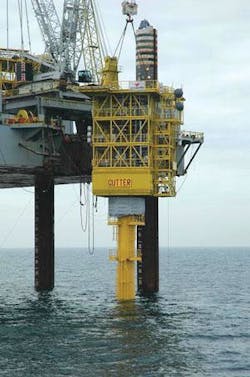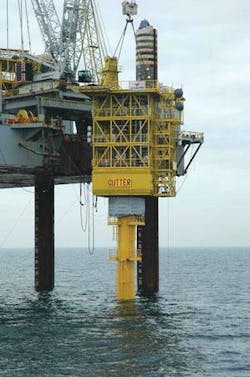Shell duplicates minimal platforms to cut cost of UK/Dutch projects
Jeremy Beckman
Editor, Europe
Twovirtually identical unmanned platforms will soon deliver first gas from separate sectors of the southern North Sea. Both are ultra-minimal facility Trident T6 Monotowers, a new low-cost, low-maintenance design conceived largely in-house by the field’s operator Shell Exploration and Production Europe.
The platforms are destined for the Cutter and K17 developments in the UK and Dutch North Sea. Both will be tied back to larger production installations, where their wellstreams will be processed for onward transfer to shore. Fabricator Genius Vos, based in Ijmuiden, The Netherlands, has built the two Monotowers concurrently, and is also responsible for offshore transportation and installation.
Shell’s coordinated approach to two unlinked projects in different regions was made possible by its recent reorganization in northwest Europe. According to a company, spokesman, “We now have a dedicated New Platforms Project team, and it was our aim to ensure we had a consistent approach to these developments. Two years ago, we would have had two separate project teams in two countries, two different platform designs and two execution campaigns. With one team, we expect to save around 11% on the costs of the facilities through synergies in procurement, installation and project management.”
Cutter is a 127-bcf accumulation located in the Cleaver Bank High area, just west of the UK/Netherlands median line. Shell and its partner Esso Exploration & Production UK started concept screening in 2003, but work was suspended later that year as Shell began its European restructuring operation.
The original five options had included two four-legged, normally unmanned installations (NUIs) with helicopter access; a two-four well subsea tieback to the Carrack QA platform; and a six-slot Trident T6 NUI, powered either via a subsea cable from another platform, or by a renewable energy package. By the time studies resumed in 2004, Shell had developed a scaled down, four-slot version of the T6, without a helipad, and this was the selected option.
A high level of reliability from simple, minimized facilities was the main criterion, deliverable through smaller topsides and a shorter offshore installation program. This combination would also help restrain costs. According to the Shell spokesman, “Cutter’s platform and K17’s will also be powered exclusively by renewable energy sources, which we expect to be cheaper in terms of life-cycle cost than a power cable from another facility. The renewables package reduces our CO2 emissions, and we also limit our environmental impact through not having to install and bury a power cable on the seabed. We believe this innovation is a world first.”
Earlier Shell Monotowers in the southern North Sea, such as Brigantine, Skiff and K7, were minimal wellhead facilities, with well conductors running through the jacket legs. For the two new platforms, jackets have been replaced by substructures comprising a single 4.2 m diameter, 50 m long pile, which will be driven to a depth of 35m, with the pile head sticking out above the seabed. The 2.5 m diameter monotower supporting the topsides will be grouted inside the monopile using a high-strength cement grout. Installations were completed during July by the work barge Seafox 4, which was equipped with a special crane to manage the work.
The Cutter QC platform will be located in 32 m of water, with produced fluids sent unprocessed through a new 19-km, 16-in pipeline connected to a riser on Carrack QA. Commingled wellstream from these two fields will then head west through an existing 20-in. line to Shell’s Clipper complex in the Sole Pit area. The Bacton control center on the English east coast will pump hydrate suppressant (monoethylene glycol) and corrosion inhibitor back to Cutter via a piggyback line to Clipper and Carrack QA.
K17 is a 185 bcf accumulation which will export gas through a new 15-km pipeline to K14 FB, then on a further 14-km to the K14 FA platform. Development work has entailed some minor changes to K14 FA to accommodate processing of K17 well fluids, and also provision of hydrate inhibitor in the opposite direction.
“The K17 installation is essentially the same as Cutter QC’s,” the spokesman explains. “The only differences relate to the two countries’ legislation requirements, infrastructure alignment, and pile length due to different soil conditions.”
LIC in Denmark has undertaken specialist foundation and structural work for the T6 substructures, the design being partly derived from foundations used in offshore wind farms. SIF in The Netherlands supplied the rolled steel sections for the piles which were then assembled and outfitted by Antwerp-based Smulders.
Both fields are being developed with two production wells, drilled and completed through the platform’s conductor piles by a cantilever jack-up - in Cutter’s case by the GSF Britannia, with the GSF Monarch handling the work on K17. Two slots have been left free on both platforms to accommodate further wells, depending on reservoir performance and future exploration of nearby prospects.
The 150 metric ton topsides will occupy an area of 10.5 sq m, with the facilities designed to withstand closed-in tubing head pressures of up to 300 barg. Main equipment comprises:
• Wellheads, manual chokes and 6-in. flowlines with metering
• 12-in. production manifold for up to four wells
•One 16-in. riser for the export pipeline to Carrack QA, and another riser handling incoming MEG/corrosion inhibitor
• Individual wellhead hydraulic power units
•Actuated riser emergency shutdown valve
•Tie-in point for a temporary pig launcher
•Instrumentation control system and navigational aids.
There will be no water treatment equipment on either platform, but around 1 bbl of condensate water/MMcf of gas is expected in Cutter’s production. Any produced water will be routed to Clipper for subsequent treatment and discharge at the Bacton terminal.
Since April 2002, Shell has trialled successfully a pilot renewable package with a dummy load of 1.2kW on the Inde K platform in the UK southern sector. Experience to date suggests the equipment can sustain this power level without outages, even in prolonged periods of dullness or flat calm. But the package on the two new platforms has higher output batteries and increased wind turbine capacity. The system is certified for Zone 1 hazardous area operation, and comprises:
•Two 6kW wind turbines supplied by Proven, based in Kilmarnock, Scotland. Both turbines are mounted on a 7 m tall mast, with 3.5 m diameter blades
•68 solar photovoltaic panels with peak output of 51kW, which can be raised or lowered hydraulically to minimize wind load
•Two 6,800 Ah battery packs weighing 6,000 kg in total. These and the solar panels have been provided by Orga in The Netherlands
• A web camera for monitoring physical parameters.
Reliance on renewable energy means there is no provision for diesel power generation on Cutter QC or K17a, and hence no need for diesel storage or bunkering activities on any of the host production platforms. “The systems are engineered to operate without intervention for two years,” says the spokesman.
According to Shell, the Cutter/K17 team has sought to maintain standardization across the two projects, and the standard T6 design will be used as far as possible for upcoming Shell developments in the southern North Sea over the next few years. One of the earliest candidates will likely be Caravel in the UK sector.
“Developments requiring either a drill center with more than four wells, or topsides facilities needing regular intervention (i.e. large quantities of sand, waxy condensate, compression) could not be used for projects like these,” says Shell’s spokesman. “However, it does appear that the vast majority of foreseeable developments in the southern gas basin lend themselves to this type of platform.•

